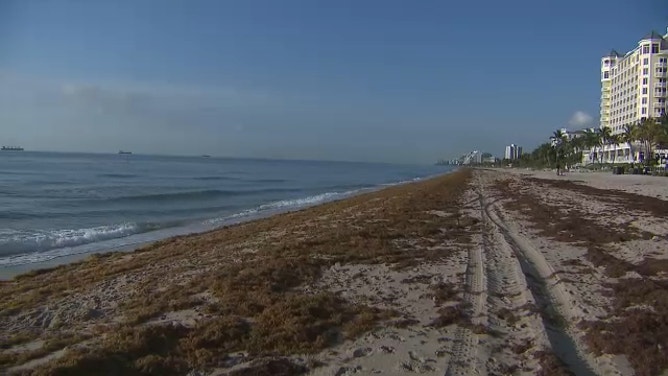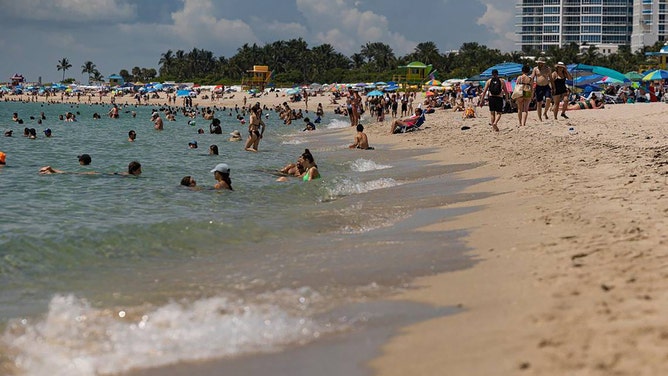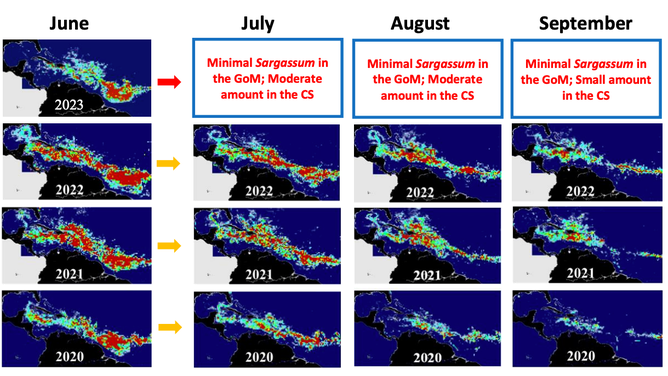Is the smelly sargassum seaweed gone for good?
A record-breaking 13-million-ton mass of sargassum seaweed was detected floating across the Atlantic Ocean back in the spring. Recently, scientists have found a drop in the amount of sargassum blooms.
Smelly sargassum seaweed clearing away from Florida beaches
Sargassum levels in south Florida were originally expected to be historic, but now experts say the seaweed is clearing away this summer. FOX Weather multimedia journalist Brandy Campbell reports. June 23, 2023.
After months of invading beaches along the Gulf of Mexico and the Atlantic Ocean, the nuisance sargassum seaweed has significantly disappeared.
A record-breaking 13-million-ton mass of sargassum seaweed was detected floating across the Atlantic Ocean back in the spring. Often called "the blob," the mass of seaweed began piling up on beaches throughout the Caribbean, Mexico and parts of the Southeast U.S.
As summer is now in full swing, however, scientists with the University of South Florida Optical Oceanography Lab found a drop in the amount of sargassum blooms.

Sargassum seaweed on a Fort Lauderdale beach. May 2023.
(Brandy Campbell / FOX Weather)
They noted that the amount of seaweed dropped by about 9 million metric tons between May and June. For comparison, the blob had grown to 13 million tons in April.
One region that saw the most significant decrease in sargassum was the Gulf of Mexico.
"Although last month we predicted a decrease in the [Gulf of Mexico] in June, the magnitude of the decrease (75%) was beyond expectation," the USF Optical Oceanography Lab said.

People enjoy the sargassum free beach on Monday, July 3, 2023, in Miami Beach, Florida.
(Alie Skowronski / Miami Herald / Tribune News Service / Getty Images)
"Minimal Sargassum amount was found in the western [Caribbean Sea], including waters along the Mexico’s [sic] Caribbean coast," they added. "Very little Sargassum was found by the end of June in the Straits of Florida and along the east coast of Florida."
SARGASSUM SEAWEED CLEARS AWAY BUT COULD STILL CREATE PROBLEMS FOR SOUTH FLORIDA BEACHGOERS
Scientists predict that the amount of sargussum will remain minimal in the Gulf of Mexico for the next 2 to 3 months.
The graphic below notes in red text the prediction for the amount of sargassum that will remain in July, August and September in the Gulf of Mexico (GoM) and the Caribbean Sea (CS).

This graphic compares the trend of decreasing sargassum from June to July, August and September for 2020, 2021, 2022 and 2023. The prediction for July, August and September (in red text) show the outlook of sargassum seaweed in the Gulf of Mexico (GoM) and the Caribbean Sea (CS).
(University of South Florida Optical Oceanography Lab / NASA)
In addition to the Gulf of Mexico, the Caribbean Sea also saw a decrease in the amount of sargassum, though not as dramatically. Most of the sargassum can be found around the Lesser Antilles and along the southern coasts of Hispaniola, Jamaica and Puerto Rico.
USF scientists predict that sargassum in the Caribbean Sea will either decrease or remain stable for the next 2 to 3 months, as well.
One region of the Sargassum Belt saw an increase in the amount of seaweed. According to the USF, the seaweed has continued to aggregate in the Central West Atlantic but has appeared to slow down.
Seaweed covers South Florida beaches
Piles of sargassum seaweed line the shores of Florida beaches.

